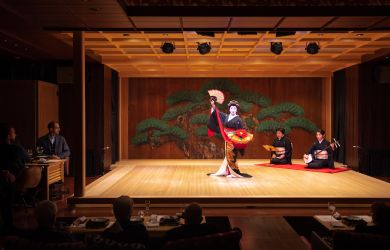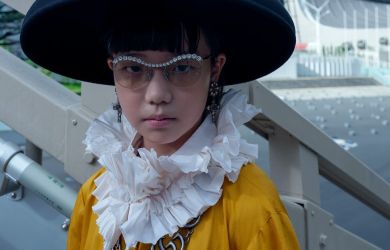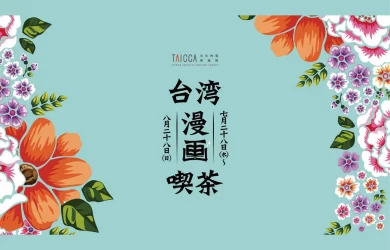
February 5, 2004
Room at the Top
A new wave of luxury hotels is shaking up the industry in Tokyo like never before. Can they all survive? Chris Betros checks in.
By Metropolis
Originally published on metropolis.co.jp on February 2004

There was a time not too long ago when older Japanese hotels like the Okura, Imperial and New Otani were consistently ranked by travel guides among the world’s top hotels and were the first choice for visitors. How times have changed. While those hotels still offer high-end accommodation, they find themselves in a race to catch up as a wave of foreign luxury hotels descends on Tokyo.
The first luxury hotel boom started in the early 1990s with the arrival of the Park Hyatt, Westin and Four Seasons at Chinzan-so. The economic bubble had burst, but those hotels had been planned long before. Then in late 2002, a new wave began with the opening of the 57-room Four Seasons Hotel facing Tokyo Station. Last year saw the Grand Hyatt (390 rooms) open at Roppongi Hills. Scheduled to open in the next three years are the Conrad (300 rooms) at Shiodome in 2005, the Mandarin Oriental (170 rooms) in Nihonbashi in 2006, the Peninsula (350 rooms) in Yurakucho in 2007 and the Ritz-Carlton (250 rooms) atop the new Tokyo Mid-town Project on the former site of the Defense Agency in Roppongi in 2008. In addition to the luxury hotels, 2003 saw the opening of Japanese hotels such as the Strings in Shinagawa, Royal Park Shiodome Tower and Park Hotel Tokyo, both at the Shiodome site.
According to the Ministry of Land, Infrastructure and Transport, there are 687 hotels in Tokyo (including business hotels), and a spokesman forecast that by 2007, there will be 700 hotels, providing 4,000 more rooms than there are now. But Tokyo still lags behind cities like New York and London, says Takashi Nakayama, a spokesman for Mitsui Fudosan, which is handling the Tokyo Mid-town Project in Roppongi. “As of last year, Tokyo had 5,520 top-tier hotel rooms, compared to 6,064 in New York and 6,565 in London. Up until about ten years ago, there were really no super-luxury hotels in Tokyo,” he says. Luxury rooms are generally defined by their room rates-starting at ¥40,000-¥50,000 a night.
While the hotel boom is exciting for the city, just why are all these hotels coming to Japan which can’t seem to get itself out of a recession? Is there going to be a demand for all these hotels? And how are existing hotels going to cope with the challenge?
 The decision by many foreign luxury hotels to come to Tokyo is linked to falling property prices and the redevelopment projects going on across the city. The land ministry has declared that at least 25 percent of space in newly developed projects must be reserved for facilities other than offices and residences. The 78,000-square-meter site of the Tokyo Mid-town Project-about the same size as Roppongi Hills-will include residential, commercial and office zones. The Ritz-Carlton will occupy the 45th to 54th floors of the tower and overlook four hectares of parkland.
The decision by many foreign luxury hotels to come to Tokyo is linked to falling property prices and the redevelopment projects going on across the city. The land ministry has declared that at least 25 percent of space in newly developed projects must be reserved for facilities other than offices and residences. The 78,000-square-meter site of the Tokyo Mid-town Project-about the same size as Roppongi Hills-will include residential, commercial and office zones. The Ritz-Carlton will occupy the 45th to 54th floors of the tower and overlook four hectares of parkland.
Lifestyles are changing in Tokyo. People want to live, work and play in the same area, says Nakayama. “Roppongi is going to become a new business metropolis. In this one-mile area that we will be at the heart of, one in six residents is non-Japanese, and there are 40 embassies and nine international schools. A top-class hotel is indispensable for a project like this.”
Brand loyalty will be a big factor in the hotel battle, both for inbound and outbound travelers. According to the Japan Travel Bureau, 16 million Japanese travel abroad every year. By boosting awareness of their brands in Japan among potential travelers, foreign hotel chains are positioning themselves to be the first choice of Japanese travelers no matter what city in the world they go to.

Guests at the Grand Hyatt are treated to oversize bathrooms featuring "rain showers" and flat-screen TVs
While the stakes are high, so are the risks. The luxury hotels, except for Grand Hyatt, are all undertaking the direct management of their properties themselves. There has already been one casualty. The St Regis, operated by US hotel company Starwood, was scheduled to open in Shiodome in 2005 but withdrew late last year after costs spiraled past its projected budget. That paved the way for Conrad, the Hilton’s luxury brand, to step in. It will occupy the bottom three and top ten floors of a new building.
Current occupancy rate at luxury hotels such as the Park Hyatt, Westin, Imperial and Four Seasons is about 80 percent (the Grand Hyatt is in the 90s). However, they have all seen revenue from weddings and banquets fall, while their restaurants are more sought after nowadays. “Tokyo is really a gift for hoteliers,” says Malcolm Thompson, general manager of the 178-room Park Hyatt in Shinjuku. “In most countries, hotels have to fight to get weekend business, but here people love to come to luxury hotels. The OL market is huge. Women like to come in for a nice meal, shopping and go to the spa. They want to be pampered.”
The Park Hyatt has long been a Mecca because of its New York Bar and Grill. It is now in the midst of its tenth-anniversary refurbishment, upgrading room technology, its chapel and opening a new delicatessen on the ground floor. Capitalizing on Sofia Coppola’s acclaimed movie Lost in Translation, which was filmed there in 2002, the hotel is offering a package until March 31, designed to mirror the adventures of the film’s main characters (played by Bill Murray and Scarlett Johansson). The package price of ¥530,000 includes five days’ accommodation in a suite, complimentary breakfast, use of spa facilities, introductory Japanese culture and etiquette lesson, shiatsu massage, one cocktail nightly, one dinner at Kozue restaurant, a half-day city bus tour and map of sights featured in the film (karaoke bar, arcade, strip club, etc).

Other hotels are trying to lure more visitors with less extravagant packages. The ANA Hotel is offering a short-stay plan that allows guests to check in at any time and use rooms for five to ten hours at any time of the day. The Cerulean in Shibuya and the Imperial are wooing women guests with special rates and esthetic services that include massage, nail-care service, fine dining and so on. The 680-room Tokyo Prince Hotel Park Tower, scheduled to open in the spring of 2005, will have a natural hot spring bath in its basement. At the Hilton in Shinjuku, family entertainment has become important in the lobby lounge, particularly on weekends and holidays. Clowns amuse the kids while mom and dad eat. As a Hilton spokesperson said, “In the old days, people from outside hardly came to a hotel to eat. Now they do, but they don’t want to just come in, eat and go home. They are looking for an enjoyable day out in a top-class hotel. It might only be a once-a-year occasion, for a birthday or graduation.”
 The older Japanese hotels have been jolted by the foreign invasion the most. Although they dwarf the luxury hotels-the Imperial (opened in 1890) has 1,057 rooms, the New Otani (opened in 1964) has 1,600 rooms and the Okura (opened in 1962) has 858 rooms-they know they must offer high value-added services. The Imperial has just begun a five-year, ¥17-billion renovation of guestrooms, restaurants and the main lobby.
The older Japanese hotels have been jolted by the foreign invasion the most. Although they dwarf the luxury hotels-the Imperial (opened in 1890) has 1,057 rooms, the New Otani (opened in 1964) has 1,600 rooms and the Okura (opened in 1962) has 858 rooms-they know they must offer high value-added services. The Imperial has just begun a five-year, ¥17-billion renovation of guestrooms, restaurants and the main lobby.
Through upgrading facilities and playing to its strengths, general manager Tetsuya Kobayashi is confident the Imperial will remain at the forefront. “We’ve got a lot of tradition going for us. The Imperial was established as a state guesthouse and we have had a lot of royal guests. For Japanese guests, who make up 50 percent of our clientele, that is important,” he says. “Competition is going to be severe, but on the other hand, I think there will be a lot of new opportunities. Most of the new hotels are part of projects that will draw in a lot of people and generate new demand.”
Tradition is also a selling point over at the Capitol Tokyu which recently completed its own refurbishment. General manager Noriyoshi Ohta says the blending of East and West in a tranquil setting is an attractive drawcard. “Location is a factor for us. We are near the Prime Minister’s Residence, the Diet and Imperial Palace. I think we’ll hold our own, especially since many of the new hotels are not full-sized,” he says.
Another factor that all hotels are counting on is the pet project of Prime Minister Junichiro Koizumi (who gets his hair cut by the Capitol Tokyu Hotel barber, by the way) to double the number of tourists to 10 million a year by 2010.
It’s high time, says the Park Hyatt’s Thompson. “There should be a much bigger demand for inbound tourist traffic. Tokyo should be a magnet for leisure tourists and more conferences. That’s what will fill the rooms.”
Redevelopment projects like the Mid-town area and Roppongi Hills are already attracting a lot of international attention. “Everything happens in Roppongi. You come to Tokyo, you have to go there,” says Grand Hyatt general manager Xavier Destribats. “When you go to LA, you go to Beverly Hills. That’s the way it will be here.”
Photo credits: Park Hyatt, Grand Hyatt, Mitsui Fudosan, Chris Betros







